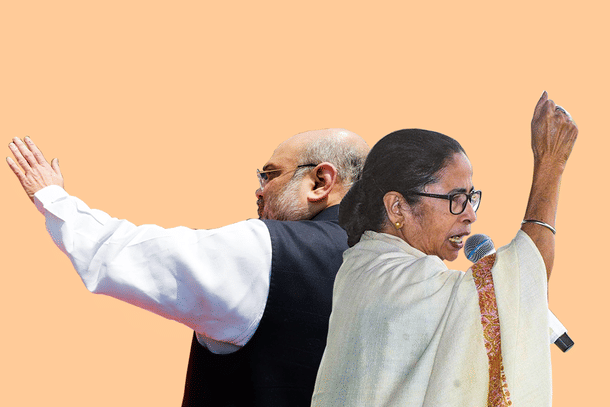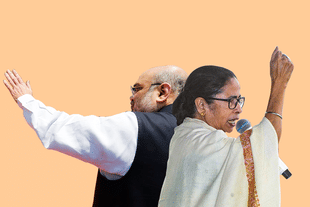Politics
Battleground Bengal: These Indicators Can Reveal Which Way The Wind Is Blowing
Jaideep Mazumdar
Mar 25, 2021, 11:07 AM | Updated 01:27 PM IST
Save & read from anywhere!
Bookmark stories for easy access on any device or the Swarajya app.


Predicting the outcomes of elections is a highly risky business. More so in a state like Bengal where trends are invisible to the untrained eye.
But to the keen political observer, there are many indicators which reveal the writing on the wall.
Having traversed the length and breadth of Bengal over the last few weeks, here are some key indicators from Swarajya that can provide an inkling of the possible electoral outcome in Bengal:
1. Mamata Banerjee hankering desperately for sympathy: A leader who is confident of winning will never take recourse to ‘drama’ to garner public sympathy.
Taking advantage of an accident to term it an ‘attack’ and then campaigning in a wheelchair with a leg in a plaster cast is a sure sign of her desperation driving her to gain public sympathy.
2. Trinamool’s past sins: People across Bengal, especially southern Bengal, are angry with Trinamool functionaries for their corrupt practices, amassing wealth, demanding commissions for even enlisting people for government welfare schemes, for running 'syndicates' and for subjecting them to threats, intimidation and terror.
Despite claims by some analysts that this anger will not rub off on Mamata Banerjee, the masses hold her responsible for their sufferings. The Trinamool chief, they say, knew what was happening but had turned a blind eye.
3. Stark decline in political violence: Elections in Bengal have always been accompanied by political violence. The degree of violence is directly proportional to the strength of the incumbent party. Only if the cadres of the incumbent party are confident of victory will they be bold enough to threaten and attack opposition cadres and functionaries.
In 2018, when the Trinamool held complete sway over Bengal, the panchayat elections were marked by unprecedented violence. But in the 2011 assembly polls when the Left cadres had sensed defeat, attacks on the Trinamool had decreased dramatically as compared to past elections.
This time, not only have incidents and the intensity of political violence declined, the Trinamool has started complaining of Bharatiya Janata Party (BJP) cadres attacking them.
4. Change in attitude of bureaucrats and cops: Bureaucrats and cops, especially those in the lower rungs, can fathom political shifts at the ground level. And that reflects in their behaviour towards politicians of different parties.
There has been a marked change in the manner in which police and government officials at the sub-divisional, block and panchayat levels interact with BJP functionaries.
Dismissiveness has been replaced with deference, and this change is obviously dictated by their self-preservation instincts: no babu or cop will take the risk of earning the ire of leaders of a party which they feel has a decent chance of forming the next government in the state.
5. Desertions from Trinamool: It is not just senior leaders of the Trinamool who have deserted the party. In many parts of the state, a vast number of workers and lower-level functionaries have also left the party to join the BJP or, at best, dissociated themselves from the Trinamool.
Political workers have their ears to the ground and are the earliest and best judges of people's electoral preferences.
6. Film and TV stars joining BJP: The Tollywood brigade joining the BJP is very significant. In Bengal, affiliation with the ruling party or being in the ruling party's good books is critical to bagging roles in films and TV series. No actor will risk his or her career to join an opposition party if that party has no chance of coming to power.
7. Visible support for BJP: People, especially in the rural areas of Bengal, prefer to keep their political preferences to themselves because displaying their political likes or dislikes could invite retribution from the ruling party cadres.
It is only when they feel they have the strength in numbers will they dare to express support for an opposition party openly. In villages across Bengal, including Trinamool strongholds in North and South 24 Parganas districts, people have started professing their support for the BJP quite openly.
8. Muslim women voters: While most Muslim men are firmly anti-BJP, the same cannot be said of the womenfolk of the community. Muslim women have benefited from the abolition of triple talaq and from various central schemes like PM Awas Yojana and Ujjwala. And they harbour a fair bit of resentment against the Trinamool for hobnobbing with and encouraging radical clerics who make women's lives difficult.
While Muslim women in overwhelmingly Muslim-dominated areas may find it difficult to vote for the BJP, those in mixed-population areas may exercise their choice more freely.
9. Hindu consolidation: Thanks to Banerjee's blatant and aggressive policy of appeasing Muslims, and the resultant muscle-flexing by the latter (especially in the rural areas), an acute undercurrent of anger exists among a huge number of Hindus.
Hindus in many parts of the state have been victims of or have silently and sullenly witnessed increasingly aggressive behaviour by Muslims and the growing radicalisation of Muslims. This has resulted in consolidation of the Hindus in vast swathes across the state. The BJP has aided and encouraged this consolidation and will be the obvious beneficiary of it.
10. Body language and speeches of leaders: A close analysis of the speeches by leaders of both the Trinamool and the BJP will reveal that the former is on the defensive.
After 10 years in power, it is evident from the angry speeches of Trinamool chief Banerjee that she is facing acute anti-incumbency. She is struggling to defend her record in governance and to stave off the aggressive attacks on her poor performance by the BJP.
Her wild, intemperate and unsavoury attacks on the BJP and Prime Minister Narendra Modi as well as Amit Shah only show that she is badly embattled.
Politicians resort to personal attacks only when they are desperate. Also, Banerjee's body language — she remains in her wheelchair and often proclaims she is ill — betray her lack of confidence. The same goes for her senior colleagues.
BJP leaders, on the other hand, exude confidence. Modi and Shah have completely ignored Banerjee's personal attacks on them and that has only intensified her frustration, leading to greater desperation on her part. And this show of desperation is not helping her at all; the masses are wise and can sense her desperation.
11. Signals from campaign trails: That leaders and candidates of a party that has been in power for a decade will attract crowds and some response from the masses is a given. But in a state like Bengal where any show of support for an opposition party invites swift and brutal retribution, the response evoked by BJP leaders and candidates on their campaign trail is significant.
As stated earlier, many people have not only been professing their support for the BJP quite openly, they have also been complaining vocally to BJP leaders about their sufferings and even against Trinamool functionaries. They would not be mustering the courage to do so had they been unsure of the BJP's electoral prospects.
All these factors need to be studied and analysed closely to decipher which way the wind is blowing in Bengal. A correct reading of these tea leaves will reveal that the BJP has emerged as a formidable force in Bengal and is confident of dislodging the Trinamool from power.
BJP leaders have been confidently projecting victory, thus influencing popular political perception. And in politics, as everyone knows, perceptions matter a lot.
Jaideep Mazumdar is an associate editor at Swarajya.





